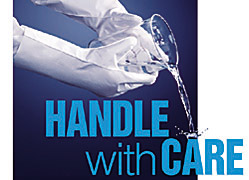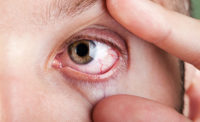
As anyone employed in the chemical industry will attest, hand safety and protection are paramount. The law currently requires that most industrial-strength chemicals be accompanied by material safety data sheets (MSDSs), and that workers handling them are appropriately trained. More and more MSDSs are also providing guidance on appropriate gloves needed to handle the respective material. In addition, safety product salespeople are providing educational tools, and chemical end-users increasingly realize the importance of technical guidance to choose appropriate gloves.
However, there are a few common yet powerful chemicals and chemical mixtures that may not trigger the same level of alertness as an industrial chemical would. These seemingly ordinary chemicals and mixtures are often overlooked because they can be purchased off the shelf from any home improvement retailer and, therefore, don't seem as dangerous as more potent chemicals. Although these products typically include an appropriate set of warnings and use instructions, users often neglect to read the fine print, leading to the possible mishandling of a hazardous substance.
Don't be fooled
As safety professionals, we are obligated to ensure the use of appropriate hand protection for all chemicals. Choosing not to wear gloves - or using the wrong gloves - for handling certain common chemicals can be just as dangerous as choosing the wrong gloves for industrial uses. Let's look at some of these so-called common chemicals that users can easily overlook and be fooled into thinking they don't need hand protection.Paint stripper is a good example of a common chemical mixture used at home. Typical paint stripper formulations include:
- Methylene chloride as a primary solvent;
- A high polarity organic chemical such as acetic acid or methanol;
- A gelling agent, which prevents the chemicals from evaporating.
Methylene chloride attacks most types of glove rubber. Instead of acting like a protective film, the rubber is likely to act as a sponge, absorbing the chemical and holding it against a worker's skin. In addition, the acetic acid or methanol penetrates through the rubber along with the methylene chloride, making the paint stripper a more powerful skin irritant. Also, the gelling agent minimizes evaporation of the other chemicals, which compounds the harmful effects.
Lacquer thinner, another example of a seemingly unharmful chemical, is a blend that typically includes:
- Ketones such as acetone or MEK; these will degrade nitrile, PVC and Viton.
- Alcohols such as methanol or isopropanol; these will degrade PVA.
- Aromatic solvents such as toluene or xylene; these will degrade neoprene, PVC, natural rubber and butyl.
Lacquer thinner should not be confused for paint thinner, which is turpentine or a synthetic substitute. The ingredients in lacquer thinner work together to degrade all of the glove materials generally available, with one exception: laminate.
Laminates not perfect
Laminate gloves, such as the Barrier from Ansell, are made by sealing together pieces of multi-layer flat plastic film. The outer layers include polyethylene, while the middle layer is a highly polar polymer such as polyamide or polyvinyl alcohol-acetate. There may also be some intermediate layers that act as adhesives to keep the entire assembly together as a single flexible film. The low-polarity layers of laminate stop high-polarity chemicals; the high-polarity layers stop low-polarity chemicals. As a result, the total glove is resistant to just about every chemical.Laminate gloves should also be the first hand-protection resource when dealing with unknown chemical spills, whether at home or externally. Until the spilled chemical is identified, laminate gloves provide the best protection when attempting to stop whatever hazard is present.
However, laminate gloves are not a complete solution for chemical handling. The films they are made from will not stretch, so laminates have to be styled for a much looser fit than, say for example, natural rubber latex gloves. The surface finish is smooth, so laminates do not have the sure grip of most rubber gloves. In addition, laminates are thin, which allows for a tear or puncture to occur relatively easily.
A liner solution
Fortunately, this thinness also provides a way of dealing with the material's disadvantages. Laminate gloves can be worn - and are commonly worn - as liners under other styles that provide the missing properties. Because laminates are thin, this can be done without much loss of dexterity.While many may not consider the need for a super-chemical glove to protect against ordinary household chemicals, it is important to remember the nature of the uses and the potential for a hazardous situation to arise.
Safety professionals need to be aware of possible damage to skin from common home products, just as we are about the industrial products we deal with every day.
SIDEBAR: Double the glove, Double the safety
We all know the old saying that two heads are better than one - meaning that two people working together on a problem are likely to come up with the best solution. Sometimes two sets of gloves, when combined together, offer workers the best solution for hand protection. The following are real-life examples of creative uses of double-gloving, or wearing one pair of gloves over another:
- Marlyse Cohen, marketing manager, Magid Glove & Safety Manufacturing Co.
